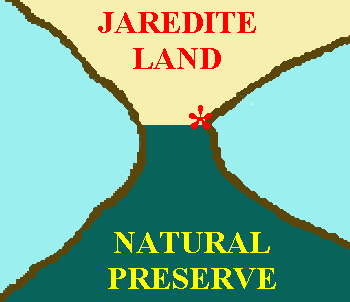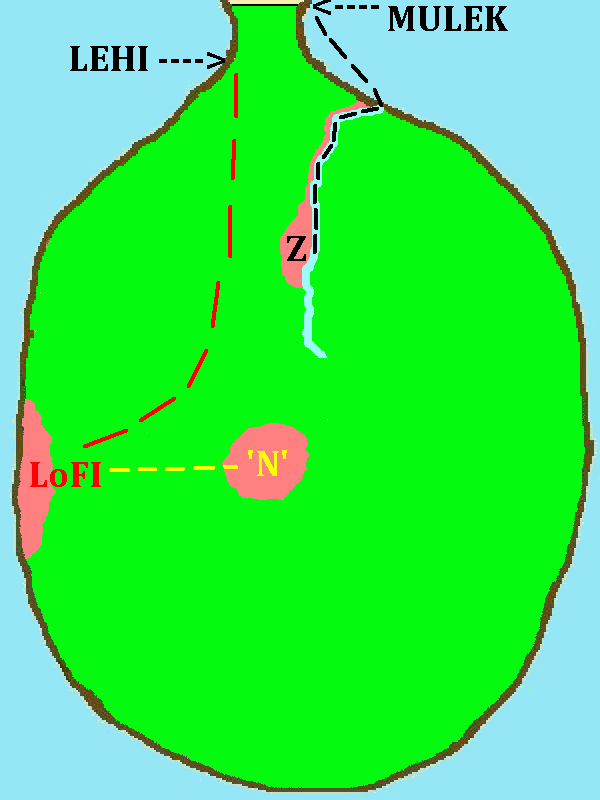
Jaredites in the Land
A misconception can develop about the Jaredite's use of the land south beyound the narrow neck which divided the two lands. Some would conclude incorrectly that the Jaredites did not venture into the land nor did they use the land to any extent. Both conclusions would be incorrect. The Jaredites did 'preserve' the land in its natural state. But that does not mean that they did not frequent it and that they did not use it. Consider our own modern methods of preserving a land. These are our national parks, forest, and wilderness areas. Do you not visit and use these lands? Yes we do, and yes the Jaredites did. The keys here is that the Jaredites had limited the use of the land, preserving its natural state. Just like we have rules for the utilization of our National Parks, forest areas, and wildernesses, so did the Jaredites have rules governing the use of the land south.

In early American Colonial times of the European age, the wilderness was a great source of goods for trade. Beaver and all manner of animal furs were of great interest. It was one of the primary ways that the frontiersman made there living in trapping and harvesting the 'game' from the wilderness. And when one considers that the sea was also a source of goods to be bought and sold, the natural perserve for game can hardly be ignored as a source of sea goods both food and other products.
In short, though the land was preserved, we must consider for what perpose and use was it preserved for? It was not just left to be a 'naturalist's' heaven, left totally prestine and untouched. It was used, and what it was used for was 'to get game,' which in an industrious nations dedicated to buying and selling and trafficing in goods, was primarily to 'get gain' from their 'getting game' from the southward land. True the land was not permanently settled with buildings and great cities, but there would be temporary 'tent' encampments at all the 'favorite' gathering places. Along the sea shores, there should be found evidences of man gathering in great abundance the goods of the sea, for trade and exporting to the land northward. Inland, there would be evidences of encampments that would be of the nature of the mobile hunter and gatherer, as they exploited the natural 'game' resources of their 'game preserve.' The Book of Mormon does not says that the land southward was not used. It only says that it was preserved for a purposeful use, to get game!
 Lehi landed on the west coast of Colombia, a little south of the Isthmus of
Darien as taken from 'The Teachings of the Prophet Joseph Smith' page
267. Lehi named the land 'Bountiful', actually the second Bountiful, the
first being that site from which Lehi's company did sail away from. Lehi's
company did remain at this Bountiful landing sight for at least one growing
season during which it produced a most bounteous crop and thus either lived
up to its name or was so Christened 'Bountiful' because of that. In this the
land was like unto that Bountiful from which they had set sail from on the
coast of Saudi Arabia. The name seems to have stuck and was remembered and
used when the Nephite people later returned and established themselves in the
land of Zarahemla.
Thus this Bountiful was the northern part of of the rain forests of which
would eventually be called the wilderness of 'Her-Mounts.' (Alma 2:37) Here
Lehi's party found domestic and wild animals of every kind as this was the
'southern preserve' left by the Jaredites. The end of the great Jaredite war
were just prior and almost contemporary with Mulek's and Lehi's landings, and
a number of the surviving domestic animals of the Jaredites had wandered into
the land south for the want of food (Alma 22:31) as Shiz had been sweeping
the land clean of life before him in his pursuit Coriantumr and his people
and his army. Thus the animals where ready, available, and waiting for Lehi's
party to round them up (1 Nephi 18:25).
Lehi landed on the west coast of Colombia, a little south of the Isthmus of
Darien as taken from 'The Teachings of the Prophet Joseph Smith' page
267. Lehi named the land 'Bountiful', actually the second Bountiful, the
first being that site from which Lehi's company did sail away from. Lehi's
company did remain at this Bountiful landing sight for at least one growing
season during which it produced a most bounteous crop and thus either lived
up to its name or was so Christened 'Bountiful' because of that. In this the
land was like unto that Bountiful from which they had set sail from on the
coast of Saudi Arabia. The name seems to have stuck and was remembered and
used when the Nephite people later returned and established themselves in the
land of Zarahemla.
Thus this Bountiful was the northern part of of the rain forests of which
would eventually be called the wilderness of 'Her-Mounts.' (Alma 2:37) Here
Lehi's party found domestic and wild animals of every kind as this was the
'southern preserve' left by the Jaredites. The end of the great Jaredite war
were just prior and almost contemporary with Mulek's and Lehi's landings, and
a number of the surviving domestic animals of the Jaredites had wandered into
the land south for the want of food (Alma 22:31) as Shiz had been sweeping
the land clean of life before him in his pursuit Coriantumr and his people
and his army. Thus the animals where ready, available, and waiting for Lehi's
party to round them up (1 Nephi 18:25).
Now Lehi's party did not remain at their landing site but rather the did journey in the wilderness as guided by such as the Liahona. Thus they would have traveled south but up the Cauca western valley of the Central and Western Cordilleras of Colombia, avoiding the impassable coastal mangrove swamps and marsh mazes of the western coast. And therefore any contact with what might have been the contemporary colonization of the Sidon Valley by Mulek's group was initially avoided. Note: this valley is also the valley traveled by Limhi's party when they failed to find Zarahemla and kept going on north into the land of Desolation.
The lands then were likely at lower elevations and easier to travel than what they would become due to the Andean uplift and the then eventual land altering destructions of the 'plate collisions' and volcanic eruptions at the time of the death of the Savior. Lehi traveled by the sites that would eventually become Noah, Ammonihah, Melek, and he'd pass through the highlands of the adjoining three cordilleras near the regions of what would become Manti. Then Lehi's party turned back toward the west coast and eventually settled in the coastal arid lands of upper Western Peru. There they found a land with ores of every kind and a land with which they were more accustomed to living in than the jungle rain forests of Colombia.
Thus Lehi's party had passed through some of the lands which would become a part of the Nation of Zarahemla. They left in their passing very little of what might have effected the later great nation. They had taken some of the Jaredite domestic herds, but certainly there were others for the Mulekites to find. They had given the name of their landing site as Bountiful which would eventually be used to identify the provincial land of Bountiful in the National land of Zarahemla. Lehi's landing port may well have been understood by and used by Hagoth as this was the approximate site where Hagoth would once again set sail into the Pacific some 550 years later. And their roughed out trail possibly left a few cleared campgrounds stopped at later by Limhi's party. But all in all, Lehi's party pretty much left the national lands of Zarahemla virtually untouched on their journey to the ore rich lands of coastal Peru.
Now with this backdrop we are ready to begin with the First Phase of the Colonization and Settlement of Zarahemla.